Through diligence and innovation, New York has been able to make the city's streets the safest of any big city in America. This month, it published a guide to help livable streets supporters anywhere replicate its success.
"Earlier this month, NYC DOT put out a major new report, Making Safer Streets [PDF], that collects before-and-after data from dozens of street redesigns and distills five key principles to reduce traffic injuries," reports Ben Fried. "It’s an accessible guide to how DOT approaches the task of re-engineering streets for greater safety."
"The DOT team hopes the report will serve as a reference not only for planners and engineers, but for any city resident who cares about street safety and wants to evaluate how streets are functioning and what would make them better," he adds. "It’s written in accessible language and comes in at under 30 pages, with a raft of graphics and photos doing much of the communication."
NYC DOT has organized its recommendations around five key principles:
- Make the street easy to use
- Create safety in numbers
- Make the invisible visible
- Choose quality over quantity
- Look beyond the (immediate) problem
FULL STORY: NYC DOT Shares Its Five Principles for Designing Safer Streets

Planetizen Federal Action Tracker
A weekly monitor of how Trump’s orders and actions are impacting planners and planning in America.

Chicago’s Ghost Rails
Just beneath the surface of the modern city lie the remnants of its expansive early 20th-century streetcar system.

San Antonio and Austin are Fusing Into one Massive Megaregion
The region spanning the two central Texas cities is growing fast, posing challenges for local infrastructure and water supplies.

Since Zion's Shuttles Went Electric “The Smog is Gone”
Visitors to Zion National Park can enjoy the canyon via the nation’s first fully electric park shuttle system.

Trump Distributing DOT Safety Funds at 1/10 Rate of Biden
Funds for Safe Streets and other transportation safety and equity programs are being held up by administrative reviews and conflicts with the Trump administration’s priorities.

German Cities Subsidize Taxis for Women Amid Wave of Violence
Free or low-cost taxi rides can help women navigate cities more safely, but critics say the programs don't address the root causes of violence against women.
Urban Design for Planners 1: Software Tools
This six-course series explores essential urban design concepts using open source software and equips planners with the tools they need to participate fully in the urban design process.
Planning for Universal Design
Learn the tools for implementing Universal Design in planning regulations.
planning NEXT
Appalachian Highlands Housing Partners
Mpact (founded as Rail~Volution)
City of Camden Redevelopment Agency
City of Astoria
City of Portland
City of Laramie




























